You’ve arrived at your destination late in the night, and room service doesn’t appeal. Don’t worry, there are still places to get some great grub even after midnight. The Business Traveller team suggests some mouth-watering options
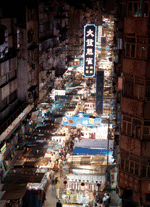
The plethora of eateries lining every inch of the street are frequented by locals and visitors alike. Browsers are accosted by hawkers’ assistants who earnestly cajole them to head for their tables. Once settled, customers are provided with a menu and their orders quickly taken.
Most of the eateries on Temple Street feature seafood, particularly shellfish. Higly recommended are local delicacies ha peng (deep-fried prawn cake), lai liu ha (fried mantis shrimps), bo zai fan (claypot rice) and chao him (stir-fried clams).
Occupying stalls 15, 19 and 21 on Temple Street, Hing Kee Restaurant (tel 852 2384 3647) opened in 1981, serving only four kinds of claypot rice. Now, it has over 42 kinds including the popular claypot congee.
Dining for two at Temple Street may cost around HK$150 to HK$200 (US$20 to US$26).
HOW TO GET THERE: Hongkong boasts an efficient MTR train system, so what better way to rub shoulders with the locals than take a train? Alight at Yau Ma Tei MTR Station and take Exit C, then make a U-turn and walk towards the street behind the exit.
Sandy Goh
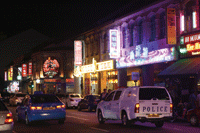 The Geylang area was an early settlement of Malay immigrants to Singapore. This remained for a good number of years until racial harmony and integration campaigns put an end to designating specific zones for people of different ethnicities. On the dark side, Geylang is also known for its sleazy bars and cheap hotels, though there’s considerable patrolling by the police in the island-state’s “red-light district”.
The Geylang area was an early settlement of Malay immigrants to Singapore. This remained for a good number of years until racial harmony and integration campaigns put an end to designating specific zones for people of different ethnicities. On the dark side, Geylang is also known for its sleazy bars and cheap hotels, though there’s considerable patrolling by the police in the island-state’s “red-light district”.
In Geylang today, brightly lit eateries line both sides of the road, which still attracts heavy traffic even at a late hour. Geylang is known for its eateries serving Chinese-style beef kway teow (fried rice noodles), bak kut teh (spiced pork bone soup) and frog’s legs, and it is easy to tell which are the well patronised places by the number of people in them.
At a little past one, we were eating at Yong He Eating House (517 Geylang Lorong 27A), a Taiwanese eatery that has been around for over 21 years. The shop, which sells a wide range of Taiwanese street food, was packed full of people ordering and chatting – a typical scenario in Geylang.
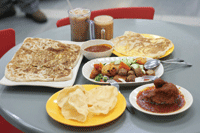 Within the next two hours, we hit two more eating places, Tasvee Restaurant (Lorong 24A) for Indian food and Soon Cheng Teo Chew Eatery (Lorong 17) which serves a Singaporean favourite, Teochew porridge. Food prices were reasonable – we ordered five to six dishes at each spot and the bill was kept below S$20 (US$14).
Within the next two hours, we hit two more eating places, Tasvee Restaurant (Lorong 24A) for Indian food and Soon Cheng Teo Chew Eatery (Lorong 17) which serves a Singaporean favourite, Teochew porridge. Food prices were reasonable – we ordered five to six dishes at each spot and the bill was kept below S$20 (US$14).
HOW TO GET THERE: Do what the locals do, take the public transport – either bus number 21 or 26 from Kallang MRT station (EW10 on the East-West MRT line) or bus number 125 from Aljunied MRT station (EW9 on the East-West MRT line). As train and bus services in Singapore do not operate 24 hours, you will need a cab to get home.
Joshua Tan
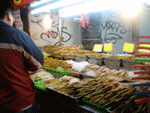
Taipei residents live by their stomach, and they can be found packing restaurants way into the night or even until the wee hours. The city abounds with night markets lined with stalls, offering vegetarian, Taiwanese, regional Chinese and Japanese dishes. You eat standing up on the road or in grubby little alleys, but the food is to die for and inexpensive. It’s always wise to go with a local who can point out the interesting buffet of animal organs such as cold duck tongue, chicken feet and heart, or what’s on the steel tray – black and white snails soaked in soya sauce.
Those who may not be able to consume such exotica can still snack on the array of grilled meatstuff sold on skewers. Sliced fruit, fresh or candied in honey, is also presented this way. Dumplings and soups are standard fare, the variety of which are astounding. A must try is the famous squid soup.
Cap the night, dropping by two well-known eateries on Fu Hsing South Road, Xiao Li Zi, famous for its Taiwanese porridge and the next-door shop for yung ho tou jiang (soy bean milk). To accompany the porridge is a host of cooked dishes, while hot and crusty cruellers complement the steaming soy bean beverage. There’s always guaranteed to be a crowd, but one manages to bag a table, whether inside with the air-con or on the sidewalk with the heat.
HOW TO GET THERE: Tong Hua is a short taxi ride from Shangri-La’s Far Eastern Plaza Hotel; Shihlin (a favourite of tourists) is northwest of the iconic Grand Hotel; and Rao He is near section 4 of Ba De Road and Song Shang Fu De Temple with Song Shan Station as the nearest subway stop. Cab it to Fu Hsing Road.
Margie T Logarta
Dining in Tokyo is 24-hour business, and we don’t mean room service. Unlike many other Asian cities, Tokyo doesn’t have anything comparable to the famous night markets one would find elsewhere, but here are a few tips.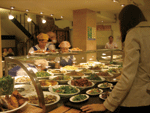
Sushi breakfast at Tsukiji fish market has become somewhat of a must-do for anyone paying a visit to this fascinating place. Previously a residential district, the district of Tsukiji (meaning reclaimed land) has been home to one of the world’s largest fish markets since 1935, a bustling place in the early hours of the morning and equally so in the evening with people feasting on the freshest fish available anywhere in the city. While sushi breakfast restaurants normally close at midday, there are a number of establishments open round-the-clock. One of the more popular choices is Sushi-Zanmai (www.kiyomura.co.jp), which has several branches all over Tokyo. There is no need to master the Japanese language as the menu is customer-friendly with pictures, and for the adventurous, simply peek at the table next to you and ask for the same.
For those in need of something closer to home, a favourite is Azabu Haus (2-7-14, Azabu 275 Building, 1F; tel 81 3 5439 6671), a small but charming Italian restaurant in the Azabu Juban district which is open 23 hours a day and closed only for an hour each morning.
They do not have a website but are mentioned in various popular food-related blogs in Japan and can be easily plotted on Google maps.
HOW TO GET THERE: Any good hotel concierge can point you in the right direction. Just take a taxi.
Wolfgang Krueger
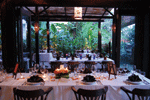 A fine-dining restaurant that specialises in Malay cuisine is still hard to come by, so Bijan caters to a niche market. It is a pleasant place to chill out with friends and entertain guests from overseas.
A fine-dining restaurant that specialises in Malay cuisine is still hard to come by, so Bijan caters to a niche market. It is a pleasant place to chill out with friends and entertain guests from overseas.
A full meal that includes appetiser, mains and dessert can cost over MYR150 (US$43), but servings are generous enough to be shared between two people. For appetisers, we decided on the sample platter which consisted of cucur udang (deep-fried prawns), papiah goreng (spring rolls stuffed with vegetables), tauhu sumbat (fried tofu stuffed with prawns and crunchy vegetables) and kepak ayam (deep fried chicken).
Our main dish was the server’s recommendation of daging panggang (slices of chargrilled marinated sirloin) served with a spicy tamarind dip. We also gave a nod to kerabu pucuk paku, a light spicy salad of wild ferns shoots tossed in a blend of lime, torch ginger and shallot dressing, which we learned was a best seller. To savour the dishes, we paired them with plain white rice. For dessert, the pandan pudding and pandan cendol ice-cream was irresistible.
The dishes, I observed, did not have the normal kick that one usually expects from Malay cuisine. The reason, my companion explained, was to accommodate those not used to spicy food.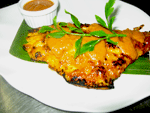
Bijan has a good selection of wines, but we opted for non-alcoholic drinks.
The service was top-notch – the staff at Bijan knew the menu inside out, and did not hesitate to provide some informed suggestions. We appreciated that.
HOW TO GET THERE: No. 3 Jalan Ceylon, 50200 Kuala Lumpur, tel 60 3 2031 3575, www.bijanrestaurant.com. Open from Monday to Saturday, 12pm to 2.30pm and 6.30pm to 10.30pm.
Gigi Onag
HONGKONG
Temple Street
Any night on Temple Street in Kowloon’s Yau Ma Tei district is a hot pot of activity. Besides the rambunctious flea market, loaded with cheap and colourful merchandise that seems to run on endlessly, as well as other diversions like fortune tellers and Cantonese opera performances, food also draws the crowds.
The plethora of eateries lining every inch of the street are frequented by locals and visitors alike. Browsers are accosted by hawkers’ assistants who earnestly cajole them to head for their tables. Once settled, customers are provided with a menu and their orders quickly taken.
Most of the eateries on Temple Street feature seafood, particularly shellfish. Higly recommended are local delicacies ha peng (deep-fried prawn cake), lai liu ha (fried mantis shrimps), bo zai fan (claypot rice) and chao him (stir-fried clams).
Occupying stalls 15, 19 and 21 on Temple Street, Hing Kee Restaurant (tel 852 2384 3647) opened in 1981, serving only four kinds of claypot rice. Now, it has over 42 kinds including the popular claypot congee.
Dining for two at Temple Street may cost around HK$150 to HK$200 (US$20 to US$26).
HOW TO GET THERE: Hongkong boasts an efficient MTR train system, so what better way to rub shoulders with the locals than take a train? Alight at Yau Ma Tei MTR Station and take Exit C, then make a U-turn and walk towards the street behind the exit.
Sandy Goh
SINGAPORE
Geylang Road
 The Geylang area was an early settlement of Malay immigrants to Singapore. This remained for a good number of years until racial harmony and integration campaigns put an end to designating specific zones for people of different ethnicities. On the dark side, Geylang is also known for its sleazy bars and cheap hotels, though there’s considerable patrolling by the police in the island-state’s “red-light district”.
The Geylang area was an early settlement of Malay immigrants to Singapore. This remained for a good number of years until racial harmony and integration campaigns put an end to designating specific zones for people of different ethnicities. On the dark side, Geylang is also known for its sleazy bars and cheap hotels, though there’s considerable patrolling by the police in the island-state’s “red-light district”.In Geylang today, brightly lit eateries line both sides of the road, which still attracts heavy traffic even at a late hour. Geylang is known for its eateries serving Chinese-style beef kway teow (fried rice noodles), bak kut teh (spiced pork bone soup) and frog’s legs, and it is easy to tell which are the well patronised places by the number of people in them.
At a little past one, we were eating at Yong He Eating House (517 Geylang Lorong 27A), a Taiwanese eatery that has been around for over 21 years. The shop, which sells a wide range of Taiwanese street food, was packed full of people ordering and chatting – a typical scenario in Geylang.
 Within the next two hours, we hit two more eating places, Tasvee Restaurant (Lorong 24A) for Indian food and Soon Cheng Teo Chew Eatery (Lorong 17) which serves a Singaporean favourite, Teochew porridge. Food prices were reasonable – we ordered five to six dishes at each spot and the bill was kept below S$20 (US$14).
Within the next two hours, we hit two more eating places, Tasvee Restaurant (Lorong 24A) for Indian food and Soon Cheng Teo Chew Eatery (Lorong 17) which serves a Singaporean favourite, Teochew porridge. Food prices were reasonable – we ordered five to six dishes at each spot and the bill was kept below S$20 (US$14).HOW TO GET THERE: Do what the locals do, take the public transport – either bus number 21 or 26 from Kallang MRT station (EW10 on the East-West MRT line) or bus number 125 from Aljunied MRT station (EW9 on the East-West MRT line). As train and bus services in Singapore do not operate 24 hours, you will need a cab to get home.
Joshua Tan
TAIPEI
Tong Hua Night Market/Shihlin Night Market/Rao He Night Market

Taipei residents live by their stomach, and they can be found packing restaurants way into the night or even until the wee hours. The city abounds with night markets lined with stalls, offering vegetarian, Taiwanese, regional Chinese and Japanese dishes. You eat standing up on the road or in grubby little alleys, but the food is to die for and inexpensive. It’s always wise to go with a local who can point out the interesting buffet of animal organs such as cold duck tongue, chicken feet and heart, or what’s on the steel tray – black and white snails soaked in soya sauce.
Those who may not be able to consume such exotica can still snack on the array of grilled meatstuff sold on skewers. Sliced fruit, fresh or candied in honey, is also presented this way. Dumplings and soups are standard fare, the variety of which are astounding. A must try is the famous squid soup.
Cap the night, dropping by two well-known eateries on Fu Hsing South Road, Xiao Li Zi, famous for its Taiwanese porridge and the next-door shop for yung ho tou jiang (soy bean milk). To accompany the porridge is a host of cooked dishes, while hot and crusty cruellers complement the steaming soy bean beverage. There’s always guaranteed to be a crowd, but one manages to bag a table, whether inside with the air-con or on the sidewalk with the heat.
HOW TO GET THERE: Tong Hua is a short taxi ride from Shangri-La’s Far Eastern Plaza Hotel; Shihlin (a favourite of tourists) is northwest of the iconic Grand Hotel; and Rao He is near section 4 of Ba De Road and Song Shang Fu De Temple with Song Shan Station as the nearest subway stop. Cab it to Fu Hsing Road.
Margie T Logarta
TOKYO
Tsukiji District
In a city that boasts in excess of 150,000 restaurants, a good meal is always available in Tokyo. There are the obvious dining choices, ranging from delightful gourmet fare in the city’s swanky five-star hotels to the traditional Japanese Izakaya (a Japanese drinking establishment) lining the back alleys of the salarymen’s district of Shimbashi. Visitors will always find recommendations in many guidebooks and magazines, be it the upmarket area of Ginza where a meal may result in having to apply for a small loan to the much less fancy, in the famous nightlife district of Roppongi.Dining in Tokyo is 24-hour business, and we don’t mean room service. Unlike many other Asian cities, Tokyo doesn’t have anything comparable to the famous night markets one would find elsewhere, but here are a few tips.

Sushi breakfast at Tsukiji fish market has become somewhat of a must-do for anyone paying a visit to this fascinating place. Previously a residential district, the district of Tsukiji (meaning reclaimed land) has been home to one of the world’s largest fish markets since 1935, a bustling place in the early hours of the morning and equally so in the evening with people feasting on the freshest fish available anywhere in the city. While sushi breakfast restaurants normally close at midday, there are a number of establishments open round-the-clock. One of the more popular choices is Sushi-Zanmai (www.kiyomura.co.jp), which has several branches all over Tokyo. There is no need to master the Japanese language as the menu is customer-friendly with pictures, and for the adventurous, simply peek at the table next to you and ask for the same.
For those in need of something closer to home, a favourite is Azabu Haus (2-7-14, Azabu 275 Building, 1F; tel 81 3 5439 6671), a small but charming Italian restaurant in the Azabu Juban district which is open 23 hours a day and closed only for an hour each morning.
They do not have a website but are mentioned in various popular food-related blogs in Japan and can be easily plotted on Google maps.
HOW TO GET THERE: Any good hotel concierge can point you in the right direction. Just take a taxi.
Wolfgang Krueger
KUALA LUMPUR
Bijan
No matter the food preference – Chinese, Malay, Indian – you can find it in the Malaysian capital. On a recent trip, my host introduced me to Bijan, which specialises in fine Malay cuisine. Tucked in a small compound along Jalan Ceylon, it offers some privacy away from the road. Alfresco sitting is available, but since it was a drizzly evening, we decided to dine indoors, which had a stylish and rustic ambience that was rather soothing after a hectic day. A fine-dining restaurant that specialises in Malay cuisine is still hard to come by, so Bijan caters to a niche market. It is a pleasant place to chill out with friends and entertain guests from overseas.
A fine-dining restaurant that specialises in Malay cuisine is still hard to come by, so Bijan caters to a niche market. It is a pleasant place to chill out with friends and entertain guests from overseas. A full meal that includes appetiser, mains and dessert can cost over MYR150 (US$43), but servings are generous enough to be shared between two people. For appetisers, we decided on the sample platter which consisted of cucur udang (deep-fried prawns), papiah goreng (spring rolls stuffed with vegetables), tauhu sumbat (fried tofu stuffed with prawns and crunchy vegetables) and kepak ayam (deep fried chicken).
Our main dish was the server’s recommendation of daging panggang (slices of chargrilled marinated sirloin) served with a spicy tamarind dip. We also gave a nod to kerabu pucuk paku, a light spicy salad of wild ferns shoots tossed in a blend of lime, torch ginger and shallot dressing, which we learned was a best seller. To savour the dishes, we paired them with plain white rice. For dessert, the pandan pudding and pandan cendol ice-cream was irresistible.
The dishes, I observed, did not have the normal kick that one usually expects from Malay cuisine. The reason, my companion explained, was to accommodate those not used to spicy food.

Bijan has a good selection of wines, but we opted for non-alcoholic drinks.
The service was top-notch – the staff at Bijan knew the menu inside out, and did not hesitate to provide some informed suggestions. We appreciated that.
HOW TO GET THERE: No. 3 Jalan Ceylon, 50200 Kuala Lumpur, tel 60 3 2031 3575, www.bijanrestaurant.com. Open from Monday to Saturday, 12pm to 2.30pm and 6.30pm to 10.30pm.
Gigi Onag








